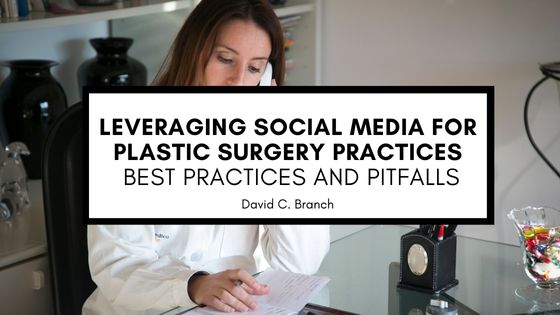In the age of digital connectivity, social media has become a powerful tool for businesses to engage with their audience and showcase their expertise. Plastic surgery practices are no exception, as they seek to connect with potential patients, build trust, and establish an online presence. In this article, we’ll explore the best practices and potential pitfalls of leveraging social media for plastic surgery practices, examining how strategic use of these platforms can benefit practitioners and their patients.
Best Practices for Social Media in Plastic Surgery:
- Educational Content: Providing educational content is a cornerstone of a successful social media strategy for plastic surgery practices. Share informative posts about different procedures, recovery processes, and potential risks. Educating your audience not only establishes your expertise but also helps manage expectations and dispel myths surrounding plastic surgery.
- Showcasing Expertise and Results: Showcase your skills and the quality of your work by sharing before-and-after photos of procedures. Highlight success stories, testimonials, and patient journeys to build trust and credibility. Transparently sharing your expertise fosters a sense of confidence in potential patients considering your services.
- Engagement and Interaction: Actively engage with your audience by responding to comments, direct messages, and questions. Encourage conversations and create a welcoming environment. Social media is a two-way street, and actively participating in discussions fosters a sense of community and connection.
- Consistent Branding: Maintain a consistent brand image across all your social media platforms. This includes using the same profile picture, cover photo, and a consistent color scheme. Consistency builds brand recognition and establishes a professional online presence.
- Use of Visual Content: Visual content is key in the field of plastic surgery. Utilize high-quality images and videos to showcase your practice, facilities, and the results of different procedures. Visual content is more likely to grab the attention of your audience and leave a lasting impression.
- Patient Privacy and Consent: Always prioritize patient privacy and obtain explicit consent before sharing any images or details related to specific cases. Ensure that you comply with healthcare regulations, such as the Health Insurance Portability and Accountability Act (HIPAA), to maintain the confidentiality and trust of your patients.
- Utilizing Multiple Platforms: Diversify your social media presence by using multiple platforms. Instagram, Facebook, Twitter, and LinkedIn cater to different demographics and provide unique opportunities for engagement. Tailor your content to each platform’s strengths while maintaining a cohesive brand message.
- Incorporating Video Content: Video content has gained significant popularity on social media. Consider creating informative videos about procedures, Q&A sessions, or behind-the-scenes glimpses of your practice. Video content humanizes your practice and can enhance the patient’s experience.
- Utilizing Influencers and Partnerships: Collaborate with influencers or establish partnerships with individuals who align with your practice’s values. This can expand your reach and bring your services to the attention of new audiences. Ensure that partnerships are authentic and resonate with your brand image.
Potential Pitfalls and Challenges:
- Ethical Considerations: One of the major pitfalls is navigating the ethical considerations associated with promoting aesthetic procedures. Practices should avoid creating unrealistic expectations or using misleading tactics to attract patients. Honesty and transparency are key to building trust.
- Negative Comments and Reviews: Social media opens the door for both positive and negative feedback. Negative comments or reviews can be challenging, but responding professionally and addressing concerns publicly or through direct messaging demonstrates your commitment to patient satisfaction and resolution.
- Overemphasis on Aesthetics: While showcasing aesthetic results is important, overemphasizing physical appearances can contribute to unrealistic beauty standards. Balance your content by emphasizing the importance of patient well-being, safety, and holistic healthcare.
- Patient Confidentiality Risks: Sharing before-and-after photos or details about specific cases poses potential risks to patient confidentiality. It’s crucial to obtain explicit consent from patients before sharing any identifying information. Implementing secure communication channels is also essential.
- Regulatory Compliance: Plastic surgery practices must adhere to healthcare regulations and guidelines when using social media. This includes compliance with HIPAA, ensuring patient privacy, and avoiding any misleading or false claims in advertisements.
- Managing Expectations: Social media can sometimes contribute to patients having unrealistic expectations about procedures. It’s essential to manage expectations by providing accurate information, emphasizing individual variations in results, and encouraging open communication during consultations.
Tips for Overcoming Challenges:
- Professional Social Media Policies: Develop and implement professional social media policies within your practice. Clearly outline guidelines for content creation, response protocols for comments and reviews, and procedures for obtaining patient consent. Regularly educate staff about these policies.
- Robust Patient Education: Prioritize patient education through your social media channels. Emphasize the importance of realistic expectations, the recovery process, and potential risks associated with different procedures. Informed patients are more likely to have positive experiences.
- Monitoring and Managing Online Reputation: Actively monitor your online reputation by regularly checking reviews and comments. Respond promptly and professionally to any concerns or criticisms. Positive engagement can mitigate the impact of negative feedback and demonstrate your commitment to patient satisfaction.
- Continuous Staff Training: Provide ongoing training for your staff on social media best practices, patient communication, and regulatory compliance. Regular training sessions ensure that everyone on your team is aligned with the practice’s goals and values.
- Regularly Update Content: Keep your social media content fresh and relevant. Regularly update your profiles with new information, success stories, and educational content. This not only keeps your audience engaged but also demonstrates that your practice is active and up-to-date.
Leveraging social media for plastic surgery practices can be a powerful tool when approached strategically and ethically. By following best practices, navigating potential pitfalls, and continuously adapting to the evolving social media landscape, plastic surgery practices can build strong online communities, connect with prospective patients, and ultimately enhance the overall patient experience. As the digital era continues to shape the way we communicate, social media remains a dynamic and invaluable platform for plastic surgeons to showcase their expertise, educate the public, and foster trust in the pursuit of aesthetic goals.

